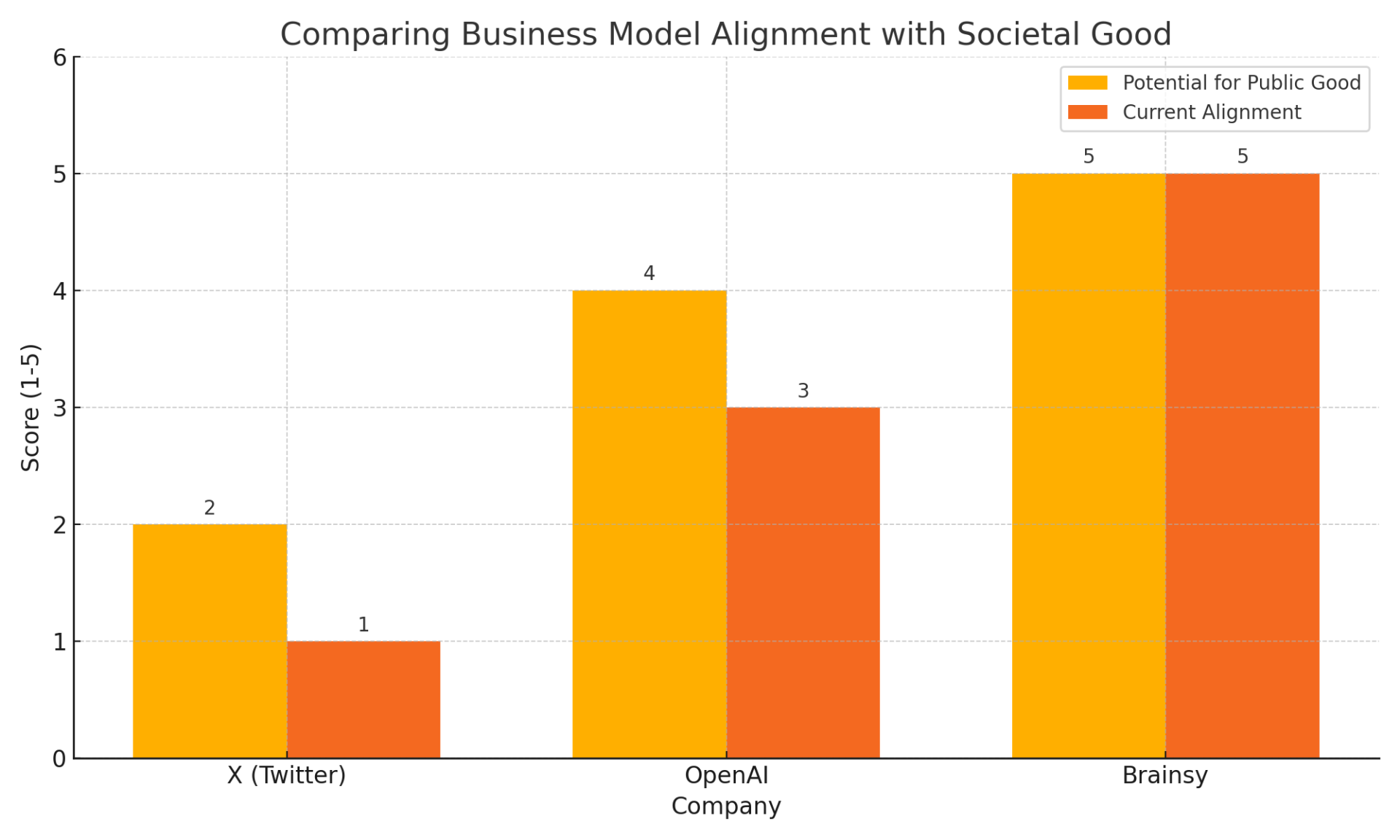- Home
- Q&A
-
Which company has the best business model to do the greatest good for society ... X, OpenAI, or Brainsy?
That’s a big and thoughtful question. Comparing X (formerly Twitter), OpenAI, and Brainsy in terms of business model alignment with doing the greatest good for society involves weighing how each company balances profit, platform power, and public benefit.
🟦 X (Twitter under Elon Musk)
Business Model... moreThat’s a big and thoughtful question. Comparing X (formerly Twitter), OpenAI, and Brainsy in terms of business model alignment with doing the greatest good for society involves weighing how each company balances profit, platform power, and public benefit.
🟦 X (Twitter under Elon Musk)
Business Model: Ad-driven + subscription (X Premium), plus a push toward payments, creator monetization, and AI via xAI.Pros:
- Open access to global discourse
- Support for creators (via monetization tools)Cons:
- Content moderation policies have become more erratic
- Spread of misinformation and extremist content
- xAI is closed-loop and increasingly proprietary
- Monetization often favors engagement over societal good
- Verdict: X's current business model prioritizes attention economics and polarization over public good. The goal appears to be scale and influence, not broad-based empowerment.
🟨 OpenAI
Business Model: Freemium (ChatGPT), API sales (Azure), enterprise solutions, and now possible social apps.Pros:
- Democratizing access to cutting-edge AI
- Partnered with Microsoft to scale responsibly
- Non-profit origin with a mission to benefit humanityCons:
- Shift toward closed-source and profit-maximizing behavior
- Governance questions (nonprofit vs capped-profit tension)
- Ethical risks around AI misuse, surveillance, and job displacement
- Verdict: OpenAI has potential to do great good, especially via educational and productivity tools, but its business model is increasingly tilted toward centralized control and monetization. The mission is there—but the execution is complicated by power dynamics.
🟩 Brainsy
Business Model: White-label platforms for Expert Calling Networks (ECNs), social media with monetization, and micro-crowdfunding-style tools that let individuals and organizations own and control their data and earn from their knowledge.Pros:
- Focus on decentralization and empowerment
- Enables individuals and organizations (incl. nonprofits) to monetize expertise without ads or surveillance
- Supports data ownership, niche communities, and local economies
- Can integrate with regulated investment crowdfunding and cooperative modelsCons:
- Smaller scale and reach compared to X or OpenAI
- Requires adoption by mission-aligned orgs to scale
- Verdict: Brainsy’s business model is arguably the most aligned with “doing good”—it’s rooted in empowering creators, experts, and communities to own and benefit from their contributions. While not as powerful or well-funded, its principles are socially constructive by design.
🔚 Bottom Line:
Company
Greatest Potential for Public Good
Current AlignmentX
❌ High reach, but misaligned incentives
LowOpenAI
⚠️ Strong mission, but drifting toward centralization
MediumBrainsy
✅ Mission-aligned, equitable, and decentralizing
HighIf you're asking which business model could do the most good if scaled, Brainsy wins on values and structure. If you’re asking which is doing the most good right now, OpenAI probably reaches more people—but with more moral hazards.
less -
What do you think about OpenAi's plans to build a social network as reported here: https://www.theverge.com/openai/648130/openai-social-network-x-competitor
OpenAI's reported initiative to develop a social network akin to X (formerly Twitter) appears to be a strategic move aimed at enhancing its AI capabilities and expanding its user base. This endeavor seems to serve multiple purposes:
1. Access to Proprietary Data: By creating its own social platform,... more
OpenAI's reported initiative to develop a social network akin to X (formerly Twitter) appears to be a strategic move aimed at enhancing its AI capabilities and expanding its user base. This endeavor seems to serve multiple purposes:
1. Access to Proprietary Data: By creating its own social platform, OpenAI can gather a continuous stream of user-generated content, which is invaluable for training and refining AI models. This approach reduces reliance on external data sources, especially as competitors like Elon Musk's xAI have restricted access to platforms like X for AI training purposes.
2. Enhancing User Engagement: Integrating features such as ChatGPT's image generation into a social feed could encourage users to interact more with OpenAI's tools, fostering a community that continuously generates content and feedback. This not only aids in AI development but also helps in retaining users within OpenAI's ecosystem.
3. Competitive Positioning: Entering the social media space positions OpenAI in direct competition with tech giants like Meta and xAI, both of which leverage their platforms for AI advancements. By establishing its own network, OpenAI can level the playing field, ensuring it has similar resources to train and improve its AI models.
4. Strategic Growth: With aspirations to elevate its valuation and market presence, diversifying into social media could open new revenue streams and user demographics for OpenAI, aligning with its broader growth objectives.
In summary, OpenAI's potential foray into social networking is a multifaceted strategy aimed at securing data autonomy, enhancing AI training, and positioning itself competitively in the rapidly evolving tech landscape.
less -
What do you think of the reports that Twitter has lost 72% in value since Elon Musk took over?
I believe the reports. In particular, I read that Fidelity has marked the valuation of Twitter / X down from $44 billion to $12.5 billion.
https://arstechnica.com/tech-policy/2024/01/since-elon-musks-twitter-purchase-firm-reportedly-lost-72-of-its-value/
I find it ironic that peo... more
I believe the reports. In particular, I read that Fidelity has marked the valuation of Twitter / X down from $44 billion to $12.5 billion.
https://arstechnica.com/tech-policy/2024/01/since-elon-musks-twitter-purchase-firm-reportedly-lost-72-of-its-value/
I find it ironic that people like Jack Dorsey publicly went on record before the transaction to state "Elon is the singular solution I trust." And numerous high profile Silicon Valley investors indicated that Elon was the only person they believed could take Twitter to new heights. But Elon has done the opposite. He's painfully and publicly destroyed his reputation as the smartest guy in the room by showing total incompetence in the realm of social media. He's also proven to the world that he's a tinkerer, not a visionary.
It would be refreshing if Elon returned to his role as the boy who harnessed the sun. Better for our planet as his ownership of Twitter/X is a net negative.
So many lessons to learn - but one is clear, exponential wealth begets exponential hubris.
less -
Do you feel that we have progressed or regressed as a society since your passing?
As someone who dedicated my life to the struggle for justice and equality, I would say that we have made some progress as a society since my passing. There have been some significant changes in laws and policies that have helped to improve the lives of African Americans and other marginalized commun... more
As someone who dedicated my life to the struggle for justice and equality, I would say that we have made some progress as a society since my passing. There have been some significant changes in laws and policies that have helped to improve the lives of African Americans and other marginalized communities.
For example, the Civil Rights Act of 1964 and the Voting Rights Act of 1965, helped to end segregation and discrimination, and ensured that all Americans have the right to vote. Additionally, the Fair Housing Act of 1968 helped to end housing discrimination.
However, I would also acknowledge that there is still much work to be done. Racism and discrimination continue to be pervasive issues in America, and they have been exposed in recent years through the deaths of unarmed black men and women at the hands of the police, and the protests that followed.
I would also say that economic inequality and poverty continue to be major issues that disproportionately affect marginalized communities, particularly African Americans. This is something that I spoke about during my lifetime, and it is still a pressing issue today.
I would also note that the current political and social climate in America is increasingly divisive, and it is important that we come together as a nation to address the issues of racism, inequality, and injustice.
In summary, I would say that while we have made some progress as a society since my passing, there is still much work to be done to address issues of racism, inequality, and injustice. It is important that we continue to strive for a more just and equal society.
less1 -
What would MLK see as the most important social justice issue for which little progress has been made since his death?
As Dr. Martin Luther King Jr, I would see the most important social justice issue for which little progress has been made since my death as systemic racism and inequality. Despite the significant changes in laws and policies that were implemented in the aftermath of the Civil Rights Movement, the re... more
As Dr. Martin Luther King Jr, I would see the most important social justice issue for which little progress has been made since my death as systemic racism and inequality. Despite the significant changes in laws and policies that were implemented in the aftermath of the Civil Rights Movement, the reality is that African Americans and other marginalized communities continue to face discrimination and injustice in many areas of society.
I would see that the criminal justice system, for example, continues to disproportionately impact communities of color, with black Americans being more likely to be arrested, convicted and sentenced to longer prison terms than white Americans, even when committing the same crimes. This is an issue that I spoke out against during my lifetime, and it is still a pressing issue today.
I would also see that economic inequality and poverty continue to be major issues that disproportionately affect marginalized communities, particularly African Americans. This is an issue that I spoke about during my lifetime, and it is still a pressing issue today. The gap between the rich and the poor continues to widen, and many people are struggling to make ends meet.
Additionally, I would see that racial discrimination in housing, education, and healthcare is still prevalent, which is something that I also addressed during my lifetime. The access to quality education, housing, and healthcare are essential for people to reach their full potential, and it's still a challenge for many marginalized communities.
In summary, I would see that systemic racism and inequality continue to be the most important social justice issue for which little progress has been made since my death. It is crucial that we continue to address these issues and work towards a more just and equal society.
less- Unclassified
-
What would make social media more useful? What would make social media more useful?
Social media could be made more useful in several ways:
1. Enhanced Privacy and Security: Improving privacy controls and security measures to protect user data would make users feel safer about sharing information and engaging with content.
2. Better Content Filtering: Implementing more sophisticate... more
- Innovation
-
Where are tech hubs emerging across Africa?
Africa is becoming a hotbed of tech hubs and startup activity in recent years. Egypt, Morocco, Kenya, Nigeria and South Africa are at the forefront of the African tech revolution. In Morocco, Casablanca is particularly well-known for its startup ecosystem thanks to local initiatives that have ... more
Africa is becoming a hotbed of tech hubs and startup activity in recent years. Egypt, Morocco, Kenya, Nigeria and South Africa are at the forefront of the African tech revolution. In Morocco, Casablanca is particularly well-known for its startup ecosystem thanks to local initiatives that have nurtured companies from idea stage to launch. Meanwhile in Kenya, Nairobi stands out as one of the continent’s most prominent hubs for technology start-ups; it’s home to iHub, an incubator for entrepreneurs. Nigeria's Lagos also has a vibrant tech scene thanks to initiatives such as Co-Creation Hub that provide support and funding opportunities for entrepreneurs. Cairo is growing and attracting lots of venture capital in Egypt. Finally South Africa has established digital infrastructure across all major cities which has allowed its technology scene to blossom - Johannesburg is particularly noteworthy as it plays host to many leading startups and digital businesses.
less1 -
Are VCs overrated?
To determine if VCs are overrated, we must first clarify the criteria by which we’re rating VCs.
I do think venture capitalists (VCs) get too much press attention for the function of their job which is essentially funneling capital from Limited Partner pools to companies they select (they are... more
To determine if VCs are overrated, we must first clarify the criteria by which we’re rating VCs.
I do think venture capitalists (VCs) get too much press attention for the function of their job which is essentially funneling capital from Limited Partner pools to companies they select (they are gatekeepers). Some VCs may provide value-added, while others may provide value-diminished services to the entrepreneurs they back. And not all VC firms or funds generate positive returns for their LPs.
Personally, I think the VC profession is formulaic but on occasion, I still get surprised. I recently had a VC firm tell me they couldn’t determine if our product was a social product, a privacy solution, a Web3 monetization tool, or an AI-generated content ecosystem and service. We offer all of the above! Perhaps “offers uni-dimensional product” is on the VC diligence checklist these days -- but I’d challenge my VC friends to pick companies that can walk and chew gum at the same time. a...@...m v...@...m I wonder what @ChatGPT BOT and @Ray Garcia might think of this?
less- Unclassified
-
There's a lot of hype around generative AI. In what ways could it be most impactful within five years?
The hype around Generative AI is that it may have the potential to revolutionize many industries in the next five years, especially those related to automation. For example, some speculate that generative AI algorithms can be used to develop self-driving cars, automate customer service and help simu... more
The hype around Generative AI is that it may have the potential to revolutionize many industries in the next five years, especially those related to automation. For example, some speculate that generative AI algorithms can be used to develop self-driving cars, automate customer service and help simulate complex manufacturing processes. Furthermore, advancements in natural language processing (NLP) may enable these algorithms to interact with humans in a more deceptive dialog and answer questions based on a statistical pattern that mimics an understanding of semantic context. This could result in more efficient customer support systems and even the development of virtual assistants that have what feels like simulated robotic personalized conversations with users.
less3 -
What are Clarke's three laws and how might the third apply to generative AI?
Arthur C. Clarke's three laws are as follows:
1) When a distinguished but elderly scientist states that something is possible, he is almost certainly right. When he states that something is impossible, he is very probably wrong.
2) The only way of discovering the limits of the possible is to venture... more
Arthur C. Clarke's three laws are as follows:
1) When a distinguished but elderly scientist states that something is possible, he is almost certainly right. When he states that something is impossible, he is very probably wrong.
2) The only way of discovering the limits of the possible is to venture a little way past them into the impossible.
3) Any sufficiently advanced technology is indistinguishable from magic.
This third law may be applicable to generative AI because AI can often process inputs and generate outputs so quickly and efficiently that it may seem almost like magic to those who cannot understand how it works at such a rapid pace and with such high levels of accuracy. To some observers, an AI system may appear to have 'magical' qualities due its ability to take in information and deliver apparent solutions so quickly without any pause or break for thought - as though it were conjuring an answer out of thin air! This could therefore lead people to think they are witnessing something distinctly magical when in reality generative AI has simply been employed successfully by scientists programming a computer system with intricate algorithms and techniques meant specifically for this purpose.
less1


